Monday, March 31, 2008
Rochester: second egg
 Mariah
Mariah Kaver
Kaver Mariah and her eggs
Mariah and her eggs Well well, the second egg has arrived at about 8:30 AM. It was quite a job for Mariah. At 9:26 Kaver came in to releave Mariah so she could eat. After she came back she fell asleep, she was really exhausted the poor thing.
Well well, the second egg has arrived at about 8:30 AM. It was quite a job for Mariah. At 9:26 Kaver came in to releave Mariah so she could eat. After she came back she fell asleep, she was really exhausted the poor thing.Anyone who ever says that laying an egg is an easy thing to do is very wrong. Producing and laying 4 eggs in a very short time is quite tiring.
Great job dear Mariah!
And a very special thanks to the Kodak Rochester Falconcam for these magnificent images!
Terminal Tower Cleveland



 Images of the 11th incubationday. The embryo is growing rapidly. The little eyas is almost complete. Everything has been made, all organs, except the lungs, are there. But very very tiny. The skeleton is still completely made out of cartilage, but from this day on the ossification starts. And the little embryo does need a lot of growing in the next 22 days. There is food enough for the little one. The circulation within the egg takes care of bringing nutrients from the yolk to the circulation of the embryo.
Images of the 11th incubationday. The embryo is growing rapidly. The little eyas is almost complete. Everything has been made, all organs, except the lungs, are there. But very very tiny. The skeleton is still completely made out of cartilage, but from this day on the ossification starts. And the little embryo does need a lot of growing in the next 22 days. There is food enough for the little one. The circulation within the egg takes care of bringing nutrients from the yolk to the circulation of the embryo.Columbus Ohio: no 2nd egg yet


 No second egg yet. The time inbetween eggs is usualy about 48-52 hours. But it is still normal when it is about 72 hours. The older the falcon getts the more the timeinterval will be going to the 72 hours. Things like territorial disputes, stress and bad wheather can influence the time interval, because it interferes with the ovulation.
No second egg yet. The time inbetween eggs is usualy about 48-52 hours. But it is still normal when it is about 72 hours. The older the falcon getts the more the timeinterval will be going to the 72 hours. Things like territorial disputes, stress and bad wheather can influence the time interval, because it interferes with the ovulation.De Mortel
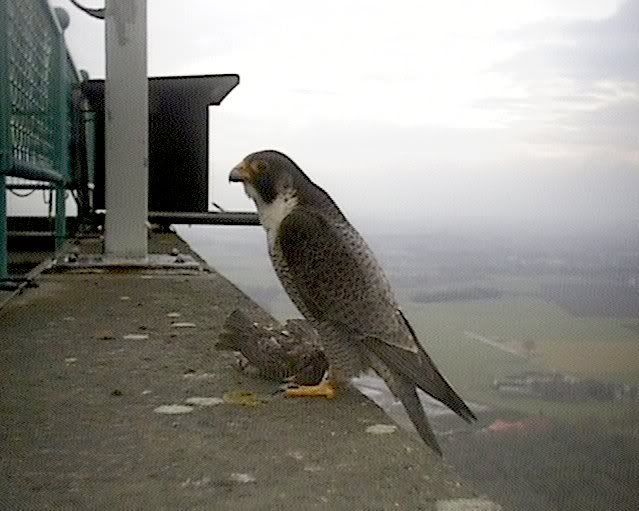
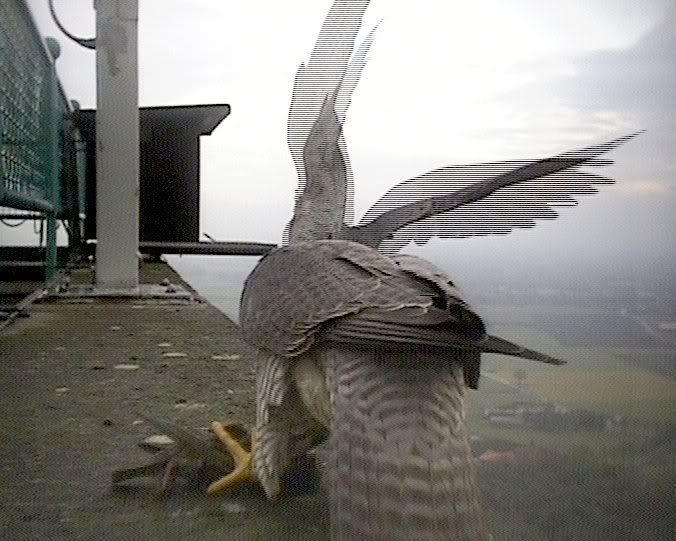
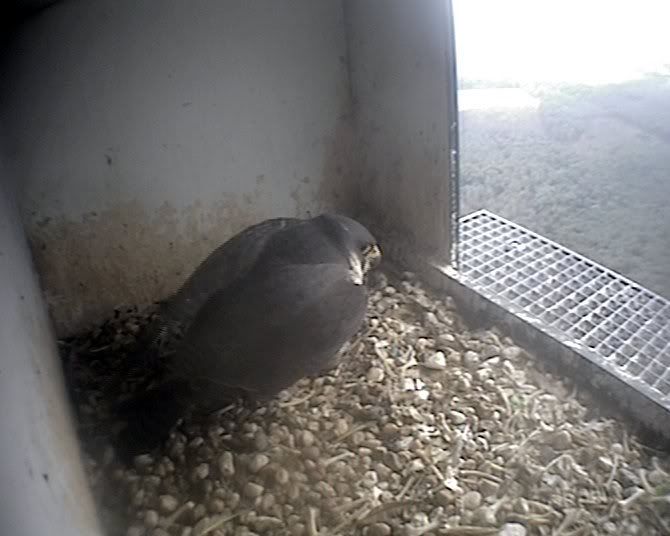
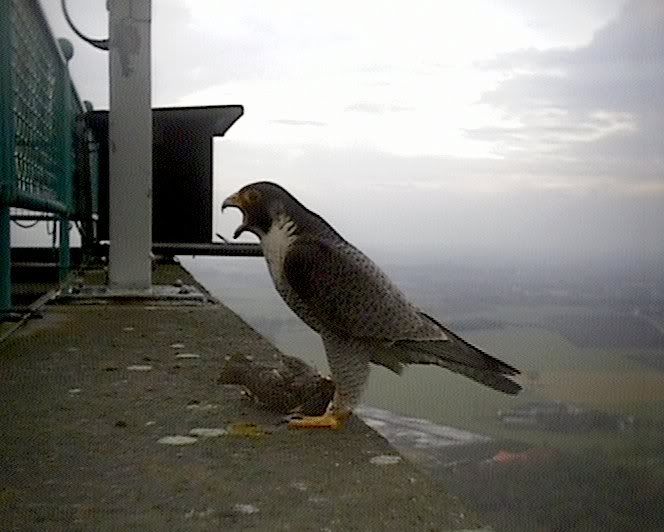
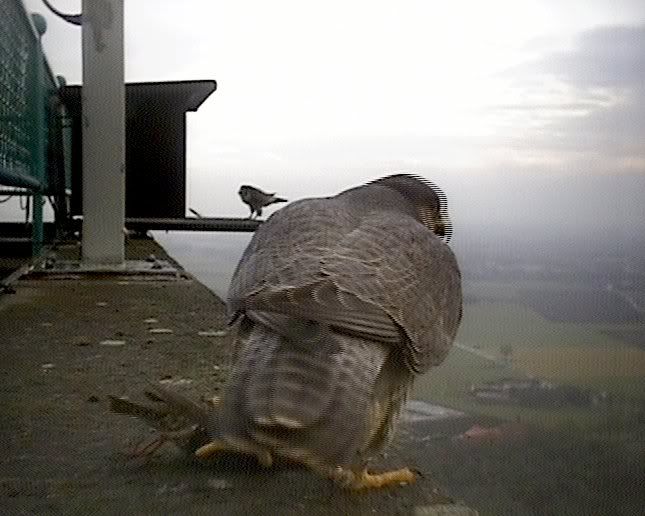
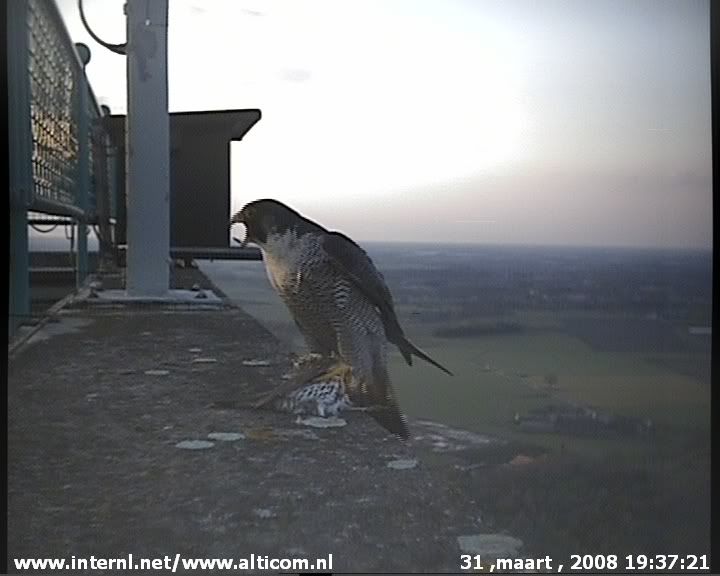
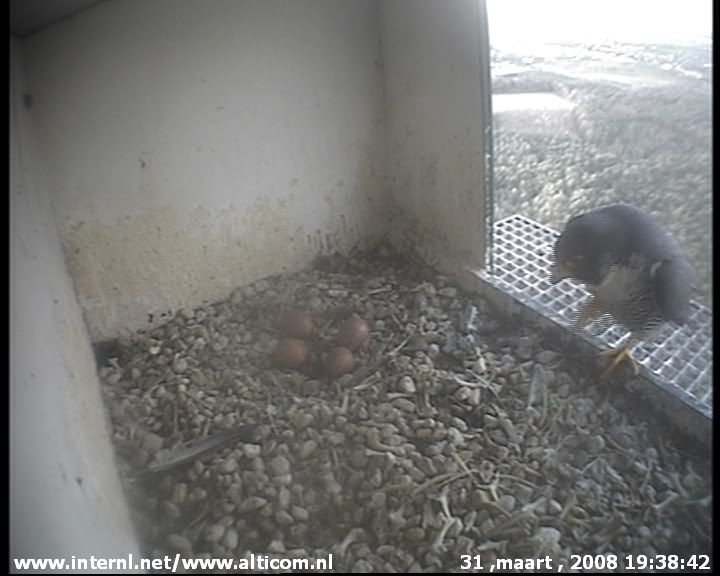
Yesterday we where in De Mortel to do some more testing with the refresh images. Seems to be working good and we are now waiting for the site to get ready, so that these 20 seconds refresh images will become available for everybody. I'll keep you updated!
Both peregrines are doing great! 4 beautiful eggs are incubated constantly. They take turns breeding and Dad is on the eggs a lot. S2 has been off the eggs and sitting in the rain just for fun all yesterday afternoon. Dad was enjoying himself sitting on the eggs. As you can see on the photo's Dad provides S2 with fine prey: he keeps his young bride satisfied. He will have to catch lots of prey once his babies are born. The parents will be very busy, the both of them raising 4 eyases. When they turn after their big mother, lots of pigeons will have to fly into their little beaks to get them strong and ready to fledge.
I plan to visit the Tower a lot, especially when the fledgelings appear on the rostrum screaming and flapping their wings. Love to see them playing with eachother up in the air. Hope to make lots of photo's of them then.
Rachel Carson

Rachel Carson is a woman I admire enormously. Thanks to her efforts and awareness we can enjoy the peregrine falcon in the world of the 21st century. Thanks to her and the efforts of so many volunteers, today we can enjoy the little eyases that are born. For only a few decades ago the peregrine falcon was almost extinct due to poisoning by DDT.
DDT was originally created in 1873. Only when its use as an insecticide was discovered in 1939, however, did it come into widespread use. The scientist who made this discovery was awarded the Nobel Prize in 1948.
After World War II, it became especially popular due to its effectiveness against mosquitoes that spread malaria and lice that carried typhus. The World Health Organization estimated that 25 million lives were saved because of its use. Problems soon surfaced, however, as many insects began to develop resistance to the insecticide. It was also discovered to be highly toxic to fish.
Because it does not break down easily, DDT builds up in the fatty tissues. Animals that ingest it, carry it for some time. It takes an animal eight years to metabolize one half of the DDT it consumes. Birds, like the bald eagle, ingested DDT after eating contaminated fish. The DDT caused the bird's egg shells to be brittle and thin and to break easily. Eggs often were broken in the nest when the parents sat on them during incubation. This was one of the reasons populations declined to dangerous levels.
DDT was banned in the United States in 1973, although it is still used in other parts of the world. Birds that migrate to other continents are still at risk.
After World War II, it became especially popular due to its effectiveness against mosquitoes that spread malaria and lice that carried typhus. The World Health Organization estimated that 25 million lives were saved because of its use. Problems soon surfaced, however, as many insects began to develop resistance to the insecticide. It was also discovered to be highly toxic to fish.
Because it does not break down easily, DDT builds up in the fatty tissues. Animals that ingest it, carry it for some time. It takes an animal eight years to metabolize one half of the DDT it consumes. Birds, like the bald eagle, ingested DDT after eating contaminated fish. The DDT caused the bird's egg shells to be brittle and thin and to break easily. Eggs often were broken in the nest when the parents sat on them during incubation. This was one of the reasons populations declined to dangerous levels.
DDT was banned in the United States in 1973, although it is still used in other parts of the world. Birds that migrate to other continents are still at risk.

She was belittled as an antihumanitarian crank, a priestess of nature, and a hysterical woman. The director of the New Jersey Department of Agriculture believed she inspired a "vociferous, misinformed group of nature-balancing, organic gardening, bird-loving, unreasonable citizenry." An official of the Federal Pest Control Review Board, ridiculing her concern about genetic mutations caused by the use of pesticides, remarked, "I thought she was a spinster. What’s she so worried about genetics for?"
Undaunted, Rachel Carson endured such attacks with a dignity, strength of conviction, and moral courage alien to her opponents. Just what had this native Pennsylvanian done to provoke these venomous and vengeful reactions? She wrote Silent Spring, a book destined to irrevocably change the course of world history.
Undaunted, Rachel Carson endured such attacks with a dignity, strength of conviction, and moral courage alien to her opponents. Just what had this native Pennsylvanian done to provoke these venomous and vengeful reactions? She wrote Silent Spring, a book destined to irrevocably change the course of world history.
Rachel Carson never claimed to be anything more than a scientist and an author. A trained marine biologist, she devoted her life to exploring, understanding, and sharing — in exquisitely lyrical prose — the wonders of ocean life. Her decision to write Silent Spring, a book warning of the hazards of pesticide misuse and abuse, was not easy. Her earlier books had revealed the beauty, the diversity, and the incredible vitality of nature. With Silent Spring, however, Carson confronted the senseless destruction of nature by a society blinded by technological progress. But she did not intend it to be a book about death.
"In each of my books," she later explained, "I have tried to say that all the life of the planet is inter-related, that each species has its own ties to others, and that all are related to earth. This is the theme of The Sea Around Us and the other sea books, and it is also the message of Silent Spring." Long before the word ecology found its way into the public lexicon, Rachel Carson spoke a philosophy of environmentalism.
Read more about this great woman and her work:
Rochester: second egg!!
 Well well, dearest Mariah, the delivery of this second egg was not easy for her! I watched her for hours of pushing and being in anguish. At 3 in the morning she was standing in the nestbox right awake trying to get the thing out. It took her more than 5 hours. But it is there. And she was really exhausted.
Well well, dearest Mariah, the delivery of this second egg was not easy for her! I watched her for hours of pushing and being in anguish. At 3 in the morning she was standing in the nestbox right awake trying to get the thing out. It took her more than 5 hours. But it is there. And she was really exhausted.As I wrote yesterday, I'm sure the territoral dispute(s) of the past days must have influenced this egg laying, as well as her advancing age. Dear, dearest Mariah, I'm so happy the egg is there. It must be a fierce falcon that's inside developing! Hope the next one will be easier. Just don't make them so big, Mariah, I know you want big strong babies, so you put all kinds of extra nutrients and hormones in your eggs. You are an exceptional mother.
Derby: second egg!!
 2 Beautiful brown-reddish eggs ! Great job dear lady falcon. We are all so happy with this second egg!! Congratulations to everybody!
2 Beautiful brown-reddish eggs ! Great job dear lady falcon. We are all so happy with this second egg!! Congratulations to everybody!Read all about the second egg here:
http://derbyperegrines.blogspot.com/
Subscribe to:
Comments (Atom)




























